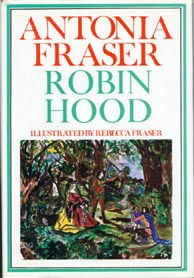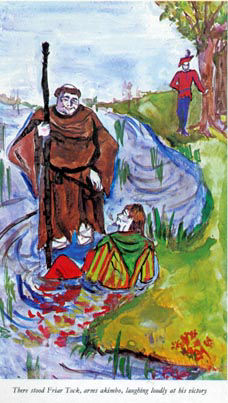Death to Prince John
Like most Robin Hood children's novels, Fraser's book borrows heavily from the classic ballads. The classic meetings with Little John and Friar Tuck, the archery competition and the rescue of Alan-a-Dale's bride are all represented. But the book does not adhere as strictly to the old ballads as Howard Pyle's book does. There is much later material with nasty Normans and the tyranny of Prince John included. While the typical episodic nature of most Robin Hood books is present, there is almost a filmic structure in how Fraser adapts the stories. When Robin Hood carries a deer's head as he crashes Prince John's banquet, the scene is highly remiscient of a classic moment from the 1938 Adventures of Robin Hood movie starring Errol Flynn.
Since the Flynn film, quite a few Robin Hood stories have opened with Robin Hood rescuing a poacher from some vicious foresters. That's the case here. However, Fraser sets the scene on a snowy Christmas eve and Robin stays in the trees, refusing to reveal his presence. The defeated Normans also encounter a snowman with a crown. This snowy effigy of Prince John has one of Robin's green-feathered arrows sticking out of it. The words "Death to Prince John" are written in the snow. It's a very effective and evocative beginning.
In this novel, Robin is the only son of the Earl of Locksley. When his father left for the Third Cruade, Robin became the ward of the Sheriff of Nottingham. In order to claim Robin's inheritance, the Sheriff and the barons Guy of Gisborne and Oswald Montdragon frame Robin Hood for an assassination attempt on Prince John. Robin's noble upbringing seems to give him an authoritarian streak, at least when he's in a bad mood. When told about Friar Tuck, Robin's reaction is somewhat unpleasant.


Contact Us